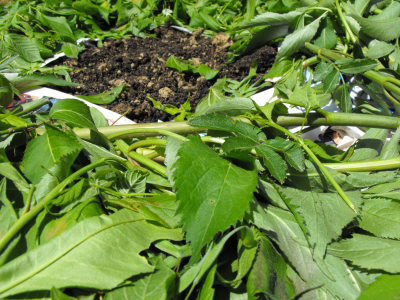
Elderberry leaf mulch
 Ever
since I read that traditional
Guatemalan farmers use young elderberry leaves as mulch
around their vegetables, I've been aching to give it a shot...and to
figure out why they focus on elderberries rather than on other
trees. The answer to that question may be a combination of early
leafing, compound leaves that are easy to pull off the trunks and quick
to decompose, and elderberry's inherent resilience. I've been
mowing over some elderberry sprouts in the mule garden for three years
now, and they just keep coming back up (and spreading), so I'm not
concerned that I'll harm my shrubs by pulling off a few leaves.
Ever
since I read that traditional
Guatemalan farmers use young elderberry leaves as mulch
around their vegetables, I've been aching to give it a shot...and to
figure out why they focus on elderberries rather than on other
trees. The answer to that question may be a combination of early
leafing, compound leaves that are easy to pull off the trunks and quick
to decompose, and elderberry's inherent resilience. I've been
mowing over some elderberry sprouts in the mule garden for three years
now, and they just keep coming back up (and spreading), so I'm not
concerned that I'll harm my shrubs by pulling off a few leaves.
Tuesday I decided to
strip the patch of elderberries by the barn as part of my neverending
search for more mulch.
The big leaves broken off quickly and easily --- if I had a good-sized
plantation of elderberries, I might not need any other source of mulch.
After I ran out of
elderberries, I moved on to the box-elders that are still sprouting up
from stumps along the garden edges. These leaves took longer to
harvest, but not by much. I just closed my gloved hand around the
base of a small branch and pulled my way to the tip, stripping off all
the leaves in my path. The result is a little bin of leaves that
densely covered a couple of raised beds.
Want more in-depth information? Browse through our books.
Or explore more posts by date or by subject.
About us: Anna Hess and Mark Hamilton spent over a decade living self-sufficiently in the mountains of Virginia before moving north to start over from scratch in the foothills of Ohio. They've experimented with permaculture, no-till gardening, trailersteading, home-based microbusinesses and much more, writing about their adventures in both blogs and books.
Want to be notified when new comments are posted on this page? Click on the RSS button after you add a comment to subscribe to the comment feed, or simply check the box beside "email replies to me" while writing your comment.

Interesting! A quick search of the internet turns this up:
Elderberry roots emit phenolics which prevent Douglas fir from growing.
The leaves and roots seem to be poisonous to humans and livestock, probably because they contain a cyanide-like compound. I can't seem to find any evidence that cyanide impacts plants, though.
So, it sounds like using the leaves as mulch won't impact plants, although their might be an allelopathic effect if I grew the elderberries close to plants I care about. (Presumably only if I grew Douglas fir, but often allelopathic plants affect more species than we know about.)